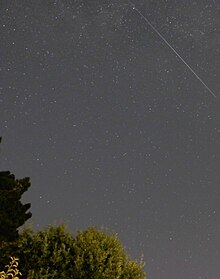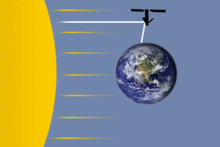Iridium flare

As satellite flare ( German iridium illumination ) is called a bright luminous phenomenon in the sky, by the reflection of sunlight on an Iridium - Satellite ignite and persist about 5 to 20 seconds. It is the brightest luminous phenomenon that artificial celestial bodies cause in the night sky; It is also possible to observe iridium flares during the day. However, since the switch to a new generation of satellites in 2019, the flares have become rare.
Emergence
The satellites form the global satellite communication system Iridium with 66 telecommunication satellites in orbit. Each of these satellites has three Main Mission Antennae (MMA) that are 188 cm long, 86 cm wide and 4 cm thick. Its surface consists of highly reflective aluminum coated with a silver-colored Teflon layer and acts as a plane mirror. The sunlight reflected by these antennas forms a narrow cone of light which, if the antenna is oriented accordingly, sweeps over the surface of the earth. On its way to earth it expands to a diameter of several kilometers and can be perceived as a luminous phenomenon. Depending on the location of the observer, it can be a faint glow that can only be seen with the naked eye, up to a glow that is comparable to a flare . An iridium flare can reach an apparent brightness of up to −9 mag and in this case glows about 50 times as bright as Venus and 1,000 times as bright as Sirius , the brightest star in the night sky.
observation

The times at which iridium flares can be seen from a certain position on earth can be calculated to the second. Corresponding orbit data and visibility forecasts can be queried online for any place on earth, see web links . The maximum brightness can only be seen on a narrow band around two kilometers wide parallel to the satellite orbit. Since the satellite orbits run over the poles, these bands run in a north-south direction. The further one is from such a band, the fainter the satellite appears. At a distance of 20 kilometers, the glow is usually no longer spectacular. Therefore, the location should be known as precisely as possible.
On average, you can see more than three Iridium flares per night, which are brighter than the star Vega in the constellation Lyra . Around once a week there is an iridium flare that is so bright that it is even visible in the daytime sky. In this case, however, the luminous appearance is much less spectacular than at night.
An iridium flare is perceived as a moving light point, the brightness of which increases to its maximum within a few seconds and then decreases again. Due to the satellites' own movement, this brightness curve is shown as a typical trace on photos with long-term exposure (see photos).
The End
From January 2017 to January 2019, eight Falcon-9 rockets launched a total of 75 satellites from the new Iridium NEXT series into low earth orbit . These replace the old satellites, which were or will be put into another orbit . The predictable Iridium flares have become rare and could be a thing of the past by the end of the 2020s ; no more flares are expected from the new satellites. Iridium CEO Matt Daesh anticipates the last Iridium flares before the re-entry of the last satellite in the mid-2040s . In February 2020, 30 of the old Iridium satellites were still in orbit.
Web links
- iridium.com: Flarewell to Iridium Flares. Information on replacing the Iridium satellites
- iridium-flare.de: Interesting facts about iridium flares
- calsky.com: Iridium Flares / Flares. Current dates for Iridium flares for every place on earth
- heavens-above.com: Iridium Flares. Current dates for Iridium flares for every place on earth (different languages, including German)
- high-iso.de: Photographing iridium flares.
- satobs.org: Catch a * Flaring / Glinting Iridium. (English)
Individual evidence
- ↑ The Iridium Flare Era is About to End. In: Universe Today. March 19, 2019, accessed July 30, 2019 .
- ↑ Space-Track.org, accessed February 18, 2020.


